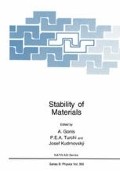Abstract
A face-centered cubic (FCC) crystal can be viewed as the …ABCABCABC… stacking of (111) planes. Stacking faults are caused by the disruption of this perfect stacking sequence. The most common fault found in a face-centered cubic (FCC) crystal, the intrinsic stacking fault, results when one atomic plane (a C plane) is removed, i.e. …ABCABABC…. When a <110|-type dislocation separates into two partial dislocations, the crystal contains an intrinsic stacking fault bounded by the two partial dislocation cores. The energy of the stacking fault determines the degree of separation and mobility of these partial dislocations. Dislocation mobility and core structure are some of the factors that influence ductility. Intrinsic stacking faults in FCC noble metals have been extensively studied experimentally,1,2and more recently theoretically.3,4 Pd1−x Ag x and Ag1−x Au x alloys form a series of FCC solid solutions over the entire range of x, Pd1−x Cu x also form a series of FCC solid solutions, though there is long range ordering at certain compositions. Thus, these three systems provide an excellent test of theoretical predictions of stacking fault energies in FCC alloys.
Access this chapter
Tax calculation will be finalised at checkout
Purchases are for personal use only
Preview
Unable to display preview. Download preview PDF.
References
P.J.C. Gallagher, Metall. Trans. 1, 2429 (1970).
I.R. Harris, I.L. Dillamore, R.E. Smallman, and B.E.P. Beeston, Phil. Mag. 14, 325 (1966).
J.M. Maclaren, A. Gonis and G. Schadler, Phys. Rev. B45, 14392 (1992).
S. Crampin, K. Hampel, D.D. Vvdensky, and J.M. MacLaren, J. Mater. Res. 5, 2107 (1990); S. Crampin, D.D. Vvedensky, and R. Monnier, Phil. Mag. A 67, 1447 (1993).
J.M. MacLaren, S. Crampin, D.D. Vvedensky, R.C. Albers, and J.B. Pendry Comp. Phys. Comm. 60, 365 (1990).
D.D. Koelling and B.N. Harmon, J. Phys. C 10, 3107 (1977).
Author information
Authors and Affiliations
Editor information
Editors and Affiliations
Rights and permissions
Copyright information
© 1996 Plenum Press
About this chapter
Cite this chapter
MacLaren, J.M. (1996). Electronic Structure of Stacking Faults in Pd1−x Cu x , Pd1−x Ag x , and Ag1−x Au x Alloys. In: Gonis, A., Turchi, P.E.A., Kudrnovský, J. (eds) Stability of Materials. NATO ASI Series, vol 355. Springer, Boston, MA. https://doi.org/10.1007/978-1-4613-0385-5_32
Download citation
DOI: https://doi.org/10.1007/978-1-4613-0385-5_32
Publisher Name: Springer, Boston, MA
Print ISBN: 978-1-4613-8028-3
Online ISBN: 978-1-4613-0385-5
eBook Packages: Springer Book Archive

